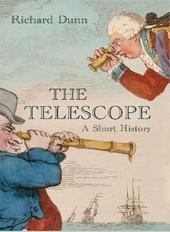
|
The Telescope: A Short History
Hardback
Main Details
| Title |
The Telescope: A Short History
|
| Authors and Contributors |
By (author) Richard Dunn
|
| Physical Properties |
| Format:Hardback | | Pages:192 | | Dimensions(mm): Height 200,Width 140 |
|
| Category/Genre | Scientific equipment, experiments and techniques
History of science |
|---|
| ISBN/Barcode |
9781844861477
|
| Classifications | Dewey:522.209 |
|---|
| Audience | |
|---|
|
Publishing Details |
| Publisher |
Bloomsbury Publishing PLC
|
| Imprint |
Conway
|
| Publication Date |
20 September 2011 |
| Publication Country |
United Kingdom
|
Description
As an instrument of science and navigation the telescope was at the forefront of discovery. Even today it is vital to modern understanding of space and the origins of matter. The story of its development is a fascinating narrative of scientific endeavour, exploration and ingenuity, encompassing the lives of scientists and astronomers such as Galileo, Newton, William Herschel and Edmund Halley as well as the exploits of naval officers and explorers like Cloudesley Shovell and James Cook. Richard Dunn presents an engaging historical survey that traces the telescope from its invention in 1608 to its contemporary applications in astrophysics. Profusely illustrated with exquisite examples of telescopes and other prints, drawings and artworks, The Telescope will appeal to all those with an interest in science, discovery and exploration, maritime history, seafaring or astronomy.
Author Biography
Richard Dunn is currently Curator of the History of Navigation at the National Maritime Museum, Greenwich. Trained as a historian of science, he has published widely on subjects including astrology, navigation, scientific instruments and museums.
ReviewsDollond is a name you probably associate more with a pair of bifocals than the cutting edge of science. Yet as Richard Dunn reveals in The Telescope: A Short History, John Dollond of Spitalfields, east London, made a pioneering contribution to the instrument's design. In 1758, he corrected an optical flaw in the type of telescope popularised by Galileo 150 years earlier. His clever arrangement of lenses thereby ensured that telescopes could be, and indeed were, manufactured in a variety of shapes and sizes. They included sights for navigational aids, opera glasses and instruments for the military. The Royal Navy even used 'Dollond' as a slang expression for telescope. Dunn, a curator at the National Maritime Museum, has ambitiously attempted to tell the instrument's entire history in under 166 pages. The book's slightly longer, because it includes a glossary of scientific terms and illustrations of telescopes at the back. But it's a somewhat staccato read because nothing is left out. Interesting characters appear and disappear in the space of a single paragraph to keep the story moving, from antiquity right up to the proposed successor to the Hubble space telescope, which is currently in orbit around Earth. The more fascinating parts, though, reveal how the telescope permeated the arts, by chronicling its appearance in paintings, plays and books. Galileo's discoveries are writ large in Adam Elsheimer's 1609 painting The Rest on the Flight into Egypt, which is reproduced in the book. And even John Milton tips a hat to the freshly revealed universe in his 1667 poem Paradise Lost. The Telescope is fascinating, but it would have benefited from a little more culture. -- Graham Southorn * BBC History Magazine *
|